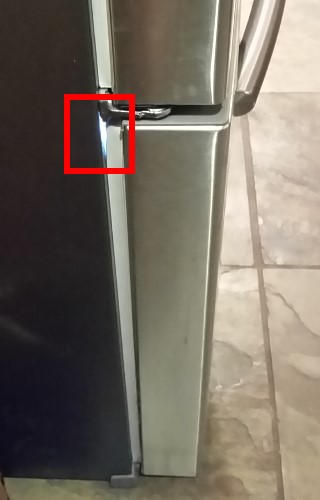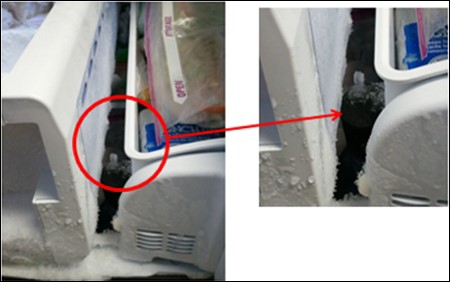|
FROST IN THE FREEZER (overcooling):
Top 5 Symptoms
- Frost/Condensation_ Freezer Room/Rail/Door
- No Cooling_All Room
- No Cooling_Freezer Room
- No Ice Production
- Keep Running Noise(fan)
PROBLEM 1: Frost Buildup Inside the Freezer
General Information
- Frost forms when warm moisture in the fridge starts to freeze. If frost is building up in your freezer, this means that warm, moist air is somehow getting inside.
- Frost in the freezer is a pretty common issue. Usually, there is nothing wrong with your fridge or freezer.
- A very thin layer of frost forming on the front of the ice bucket is normal. This is the first place that warm air hits when the dispenser flap opens and when the freezer door is opened.
SOLUTION 1A: Identify Source of Warm Air
If frost is forming in your freezer, please perform the following:
- First, please try to identify where the warm air is coming from. Pay close attention to where the frost is concentrated in your freezer. This will help determine the source of the warm air.
- For example, if there is frost forming on the right side of your freezer, the warm air is most likely entering through the right side.
- If the source of the warm air is caused by something you can fix, please correct the issue and then clean away any frost that has built up. This will prevent more warm air from getting in and will prevent the frost from forming.
- If you have identified the source of the warm air and it is caused something that cannot be corrected, such as a damaged seal, then your refrigerator will require service.
SOLUTION 1B: Make Sure The Freezer Is Closed
If you can't identify the source of warm air, please perform the following:
- Please check if freezer door is completely closing. You can test this by opening and closing the freezer door multiple times.
- If you still aren't sure if the freezer is completely closing, place a lit flashlight into the freezer, shut the door, and then turn off the room's lights.
- If any visible light is coming through from around the edge of the seal, it means the door is not completely closed.
- Make sure the freezer is not overloaded with food items, which could be blocking the door from closing.
- Please make sure nothing has fallen inside the back of the freezer, which could prevent the door from closing completely.
- Please check that frost hasn't formed on the sliding rails of the door, which could prevent the door from sliding all the way shut.
- Check that the freezer door is aligned.
- Please check that nothing is blocking the gasket when the door closes, such as the corner of a ziplock bag, or items with not enough space that are pressed against the back wall.
*If you have tried all these steps and there is still a large amount of frost, check for other possible issues.


Solution 1C: Other Reasons For Frost
If your freezer door is properly closing but frost is still building, please try some of these other options:
- Please ensure that hot or warm food has not been placed in the freezer. The warmth given off by these food items could cause frost to form.
- Make sure the vents in back of the unit are not blocked.
- Please check that the freezer door is never left open for an extended period of time. Even a period of 5 minutes can cause frost to start forming.
- If the doors were recently removed or installed, please make sure they have been installed properly and are level left to right. For further assistance, refer to your user manual or contact a professional installer.
- Please check the ice chute from time to time. Frost does not go away by itself because your freezer's low temperature prevents it from melting. It will continue to build up until it is cleaned off. Make sure no residual ice is propping open dispenser flap, which will allow warmer air into the freezer.
- Please check if the rubber gasket is dirty or damaged.
- If the rubber seal is dirty, you can clean it with a mild detergent and damp cloth.
- If the rubber seal is damaged, service is required.
*If you have tried all these steps and there is still a large amount of frost, then the refrigerator should be defrosted.
SOLUTION 2: Defrosting the Refrigerator
Defrosting your fridge is the best way to get rid of frost. Please follow the steps below:
- Please remove all your food from your fridge.
- Unplug your fridge and leave it off for at least 24 hours. This will cause the frost inside to melt.
- After 24 hours, please wipe down any excess water, and clean the inside of both your fridge and freezer. We recommend also vacuuming the back of the fridge.
- Please plug your fridge back in and let it cool for 2 hours.
- Please set your fridge's temperature to the factory standard (Fridge: 3C or 38F / Freezer: -20C or -4F).
*If you experience more frost one week after you defrosted your fridge, then please arrange service. ������������������������������������������������������������������������������������������������������������������������������������������������������������������������������������������������������������������������������������������������������������������������������������������������������������������
|
